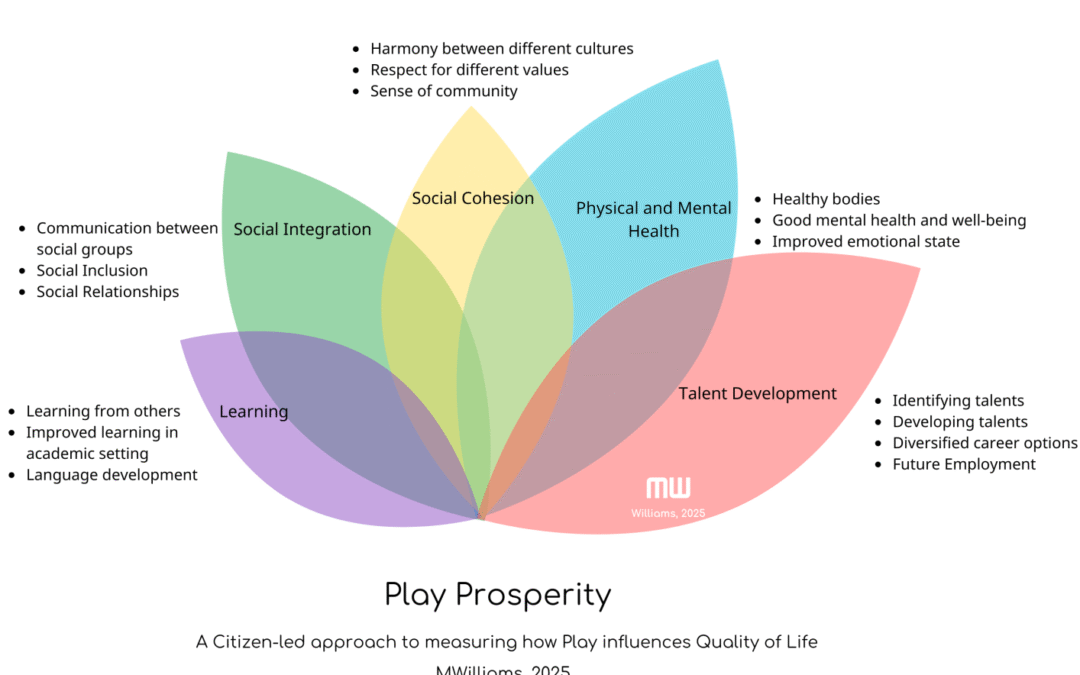To thrive where you are right now?
Play is an innate behaviour that brings us joy, spurs creativity, empowers us to connect, builds our resilience, our strength, our care for others.
Yet somehow economic growth, how much we earn or have saved away, is so often seen as a measure of prosperity.
It’s time for prosperity to join the growing number of alternative measures of prosperity that seek to shift our focus, away from economic riches, and to something much deeper-quality of life, well-being, and human connection (Stiglitz, Sen, & Fitoussi, 2009). (Stiglitz, Sen, & Fitoussi, 2009).
Play Prosperity Model
The Play Prosperity Model explores how outdoor play contributes to children’s quality of life and is based on the perspectives children and adult stakeholders such as parents, caregivers and teachers.
Rather than focusing on traditional economic metrics like Gross Domestic Product, this model embeds alternative measures of prosperity, such as well-being, social inclusion, and holistic development. Measures that provide a more holistic and less extractive view on what it looks like to have a good quality of life and prosper.

I have created this model after asking 140 adults, which included parents, teachers, NGOs and government officials, how outdoor play improves children’s quality of life. The methodology was guided by the Institute of Global (IGP) Prosperity’s Citizen Prosperity Index.
https://www.ucl.ac.uk/bartlett/igp/research/citizen-prosperity-index
The research was set in an urban host community in Kenya, where the majority of people children would be classified as poor or extremely poor. The findings revealed how play was valuable to children’s quality of life and a contributor to both a prosperous reality and future.
The community’s insights and IGPs citizen led models, enabled me to produce this model. It would not have been possible without the local citizens. I am solely the playful engineer and visual storyteller, pulling together the fabrics of their insight.
Five Key Themes of Play Prosperity
The benefits of outdoor play, as identified by local and external stakeholders, were distilled into five core themes. These themes align with broader prosperity measures, particularly those found in the City Prosperity Index (CPI) developed by UN-Habitat and the Institute for Global Prosperity’s (IGP) community-led prosperity model (IGP,2019):
1. Learning – Education Index (CPI)
Outdoor play fosters cognitive growth, creativity, and problem-solving (Gray, 2013).
Play helps children expand vocabulary, practice storytelling, and develop narrative skills, all essential for education (Weisberg et al., 2016).
2. Health – Health Index (CPI)
Play supports physical fitness, emotional resilience, and mental health (Ginsburg, 2007; WHO, 2020).
3. Social Integration – Equity & Social Inclusion Index (CPI)
Play enables friendships, social skills, and a sense of belonging (Lester & Russell, 2010).
In diverse communities, play supports multilingual learning and cross-cultural communication (Pellegrini & Galda, 1993).
4. Talent Development-Productivity Index (CPI)
Play allows children to explore and refine their skills for future opportunities (Zosh et al., 2018).
5. Social Cohesion – Governance & Civic Participation Index (CPI)
Stronger social bonds create safer, more inclusive play spaces (Putnam, 2000). Build community trust and a sense of safety.
Measuring Play Prosperity – Citizen first and localised
This model reframes prosperity beyond economic growth, highlighting well-being, inclusion, and holistic child development as essential indicators of a thriving society.
It also recognises that cultural and societal influences shape how communities define quality of life at a neighborhood level (Sen, 1999).
- The size of each theme in the model reflects how frequently it was mentioned by the community.
- 16 specific metrics were developed based on insights from 120 adults during the research’s discovery phase, ensuring they reflect local values and lived experiences.
Play is universal—but how it is valued is subjective and deeply localised
Context Matters: Comparing Kitengela, Kenya and Brockley, England
Parents and teachers repeatedly mentioned talent development in Kitengela? why, because in an environment with job opportunities were low, play was positioned as a way to develop career opportunities. Social cohesion was also a dominant theme, because their desire to create a more harmonious community admits the present ethnic tensions.
If I took this model to where we live in Brockley London, I am sure the metrics would change, as would the key themes. For example I am sure improving children’s mental health would be a priority (UK Youth, 2022). and gaining a sense of community would be an important metric, however I am not sure gaining further employment through playing would be one.
What Next?
We want to partner with organisations to refine and test out this model.
5 Key questions come to my mind?
- Is a citizen -led approach to play really valuable?
- Can it be used at local authority level to help direct funding and plans towards play?
- Are there more than 5 themes?
- Can we use this model to assess quality of life at a neighbourhood level?
- How do you measure these metrics in a meaningful manner, as opposed to an onerous one?

